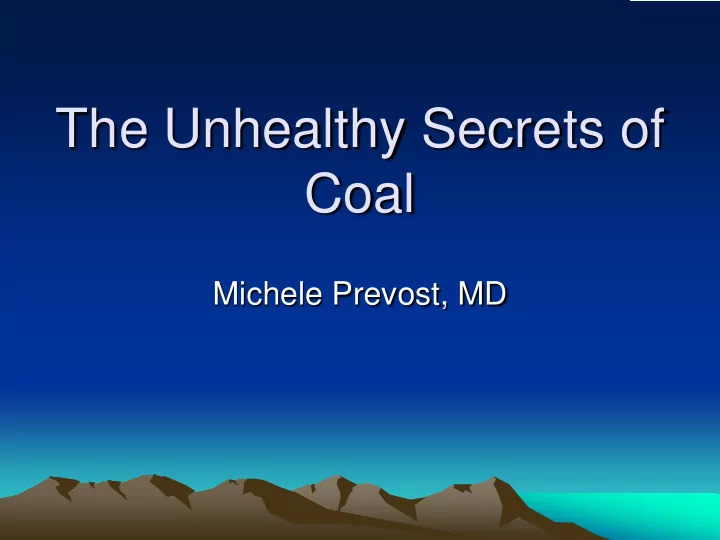

The Unhealthy Secrets of Coal Michele Prevost, MD
Why is Coal Toxic? • Toxic metals • Radioactive elements (decays to Radon) • Even “low-sulfur” coal produces bio-toxic sulfur and acidifies water • Benzene derivatives (carcinogenic)
Why is Coal Toxic? • Arsenic – known poison; various cancer & lymphoma • Lead – effects almost every body system • Mercury – Irreversible damage to nervous system • Cadmium – High Blood Pressure; kidney damage • Vanadium – Lung damage; birth defects • Selenium – Cirrhosis (liver failure); pulmonary edema (fluid in lungs); death • Others not as well studied
Adverse Health Effects of Coal A 15 Minute Primer • Coal Mining – Dust – Water • Processing • Transportation • Combustion • Combustion Waste
Coal Dust • PM10 & Smaller Particles • Black Lung Disease (pneumoconiosis) • Childhood Asthma • Linked to Lymphoma • Greatest impact on young, old & those with other lung or heart disease SEWARD COAL PROBLEMS
Coal Sludge and Water • Slurry Ponds – Concentrated toxic elements – released in large amounts – Leach for hundreds of years • Wells exceed drinking water standard >500% • Lack of biodiversity & deformed fish • Stream acidification
What if you live down-wind or down-stream? • Common Sense – pollutants that poison make people sick • Growing body of medical studies – Higher rates of premature death, COPD, Lung Cancer, other heart, lung, kidney disease, congenital abnormalities, hospitalizations (after adjusting for other factors) • Environmental degradation linked to depression
Living Near Coal Mining • Not just occupational injuries & illness • Higher rates of – Lung cancer – Hospitalization – COPD (Chronic Obstructive Lung Disease) – Hypertension (leads to heart, kidney disease) – Childhood Asthma – Injured by fly rock and trucks
Coal Processing • Chemical wash to prepare for burning • 19 are known cancer-causing agents • Often stored in slurry impoundments – Spills and failures – Contaminated water, injuries, deaths • Dried slurry waste extremely high concentration of toxics – dust or water leaching
Coal Transportation • The Trains and Trucks YES, THAT IS COAL DUST – >600,000 NOx – >50,000 tons PM • Along railway much higher than EPA recommended air toxin levels • Numerous coal-truck accidents
Coal Combustion • Most well known / studied polluter • Particulates, nitrates, sulfates, mercury • American Lung Association Estimated 24,000 deaths /year directly related • Nitrous Oxide, Sulfur Dioxides → acid rain • Acidification water increases metal leaching into waterways (vicious cycle)
Mercury • #1 source in US – coal fired power plants • Methylmercury builds up in fish, wildlife, then people • Potent neurotoxin • Disrupts fetal development
Mercury • 48 tons emitted 2005 • High amounts in predatory fish • 600,000 infants at risk annually • No safe level of exposure
Coal Combustion Waste • “Coal Ash” or CCW • 141 million tons annually in US • Kingston Dam Slurry disaster brought attention • Water in area >100x allowable levels toxic heavy metals • Widespread ground water contamination around mines & power plants in lower 48
Coal Ash - Alaska • USGS & Independent Testing of Soils in Fairbanks: – Arsenic – Vanadium – Mercury
Coal Ash - Arsenic • Primary threat to human health? • >100x allowable soil levels in AK tests • EPA: 2000x increased cancer risk living @ coal ash ponds
Conclusion • Once soils / water contaminated, may be for centuries • Cumulative public health impacts of coal extensive • Our dependence on coal not sustainable • Move beyond the industrial revolution – need a future without coal
References • Agency for Toxic Substances and Disease Registry (ATSDR); Research on the Health impacts of coal-related pollutants; 2009. • Aneja, Viney; Characterization of Particulate Matter (PM10) in Roda, Virginia, Raleigh 2009 • Brabin B; Respiratory morbidity in Merssyside schoolchildren exposed to coal dust and air pollution. Archives of Disease in Childhood 70; 1994; 305-312 • Epstein P; Testimony for the Kentucky General Assembly House of Representatives Committee on Health and Welfare; Feb 2010. • Goodell J; Big Coal; The Dirty Secret Behind America’s Energy Future; First Mariner Books; 2007 • Hendryx M, et al. Hospitalization patterns associated with Appalachian coal mining; Journal of Toxicology and Environmental Health; 2007; 70; 2064-70 • Hendryx M, Ahern MM; Relations between health indicators and residential proximity to coal mining in West Virginia; American Journal of Public Health; 2008; 98; 669-71 • Hendryx, et al.; Lung Cancer Mortality is Elevated in Coal Mine Areas of Appalachia; Lung Cancer; 2008; 62; 1-7 • National Institute for Occupational Safety and Health (NIOSH); Registry of toxic effects of chemical substances: Coal, ground bituminous; Cincinatti, OH; Centers for Disease Control; 1991. • NSW Health; Mine Dust and You; http://www.health.nsw.gov.au/factsheets/environmental/mine _dust.html
Recommend
More recommend